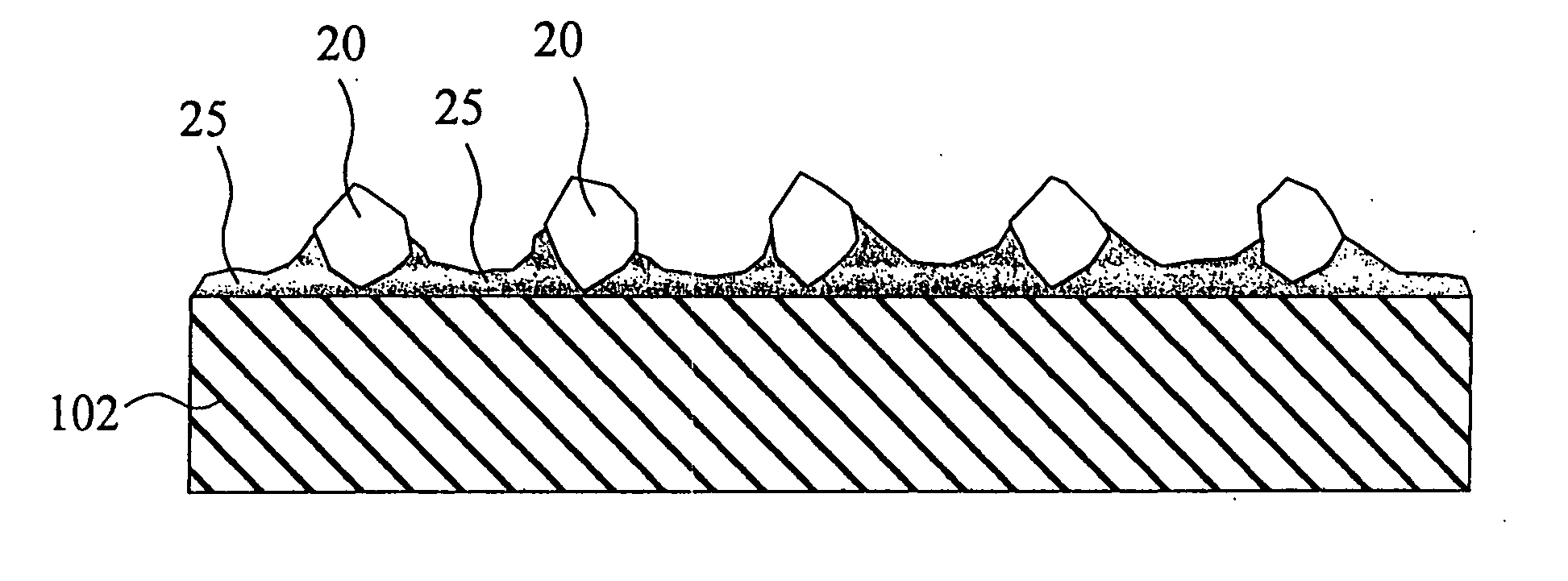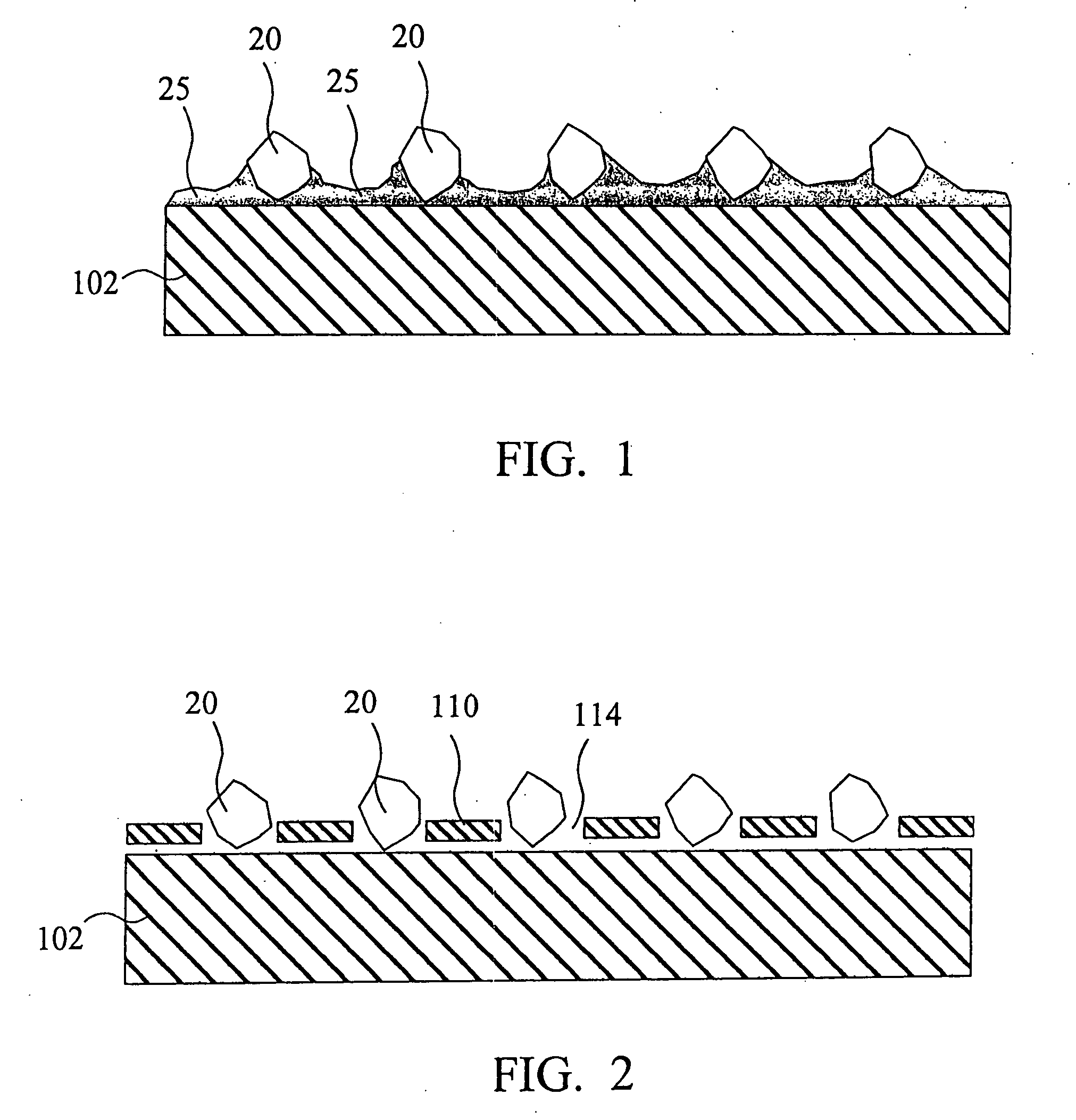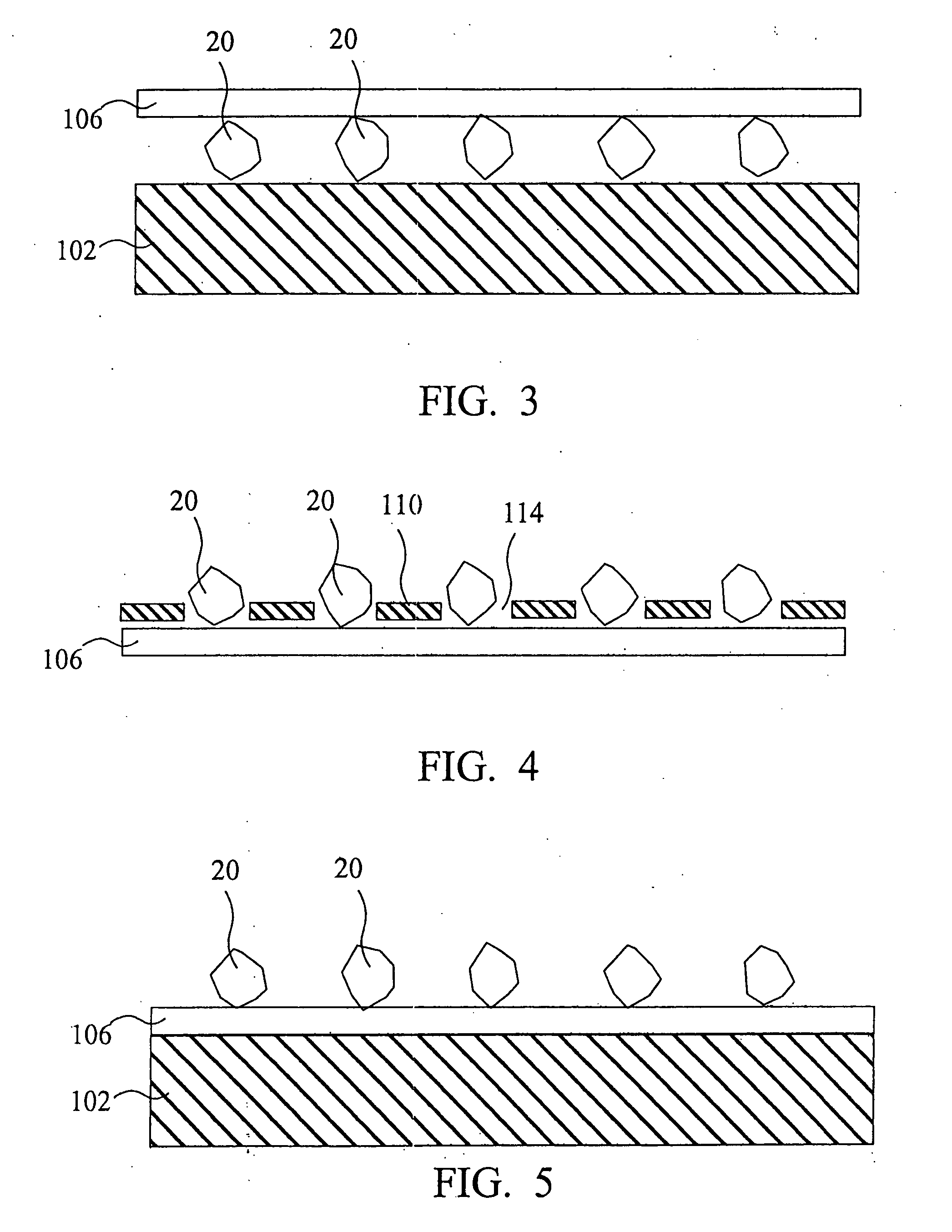If
diamond tools were not used, many such industries would be economically infeasible.
Despite their prevailing use,
diamond tools generally suffer from several significant limitations, which place unnecessary limits on their useful life.
Thus, if the diamond / CBN abrasive particles are too close to one another, some of the particles are redundant and provide little or no assistance in
cutting or
grinding.
In addition, excess particles add to the expense of production due the high cost of diamond and cubic
boron nitride.
Moreover, these non-performing diamond or CBN particles can block the passage of debris, thereby reducing the
cutting efficiency.
Thus, having abrasive particles disposed too close to one another adds to the cost, while decreasing the useful life of the tool.
On the other hand, if abrasive particles are spaced too far apart, the
workload (e.g., the
impact force exerted by the work piece) for each particle becomes excessive.
The damaged or missing abrasive particles are unable to fully assist in the
workload.
Often the tool may include a matrix support material, such as a
metal powder, which holds or supports the diamond particles However, because diamond or cubic
boron nitride is much larger than the matrix
powder (300 times in the above example for making saw segments), and it is much lighter than the latter (about 1 / 3 in density for making saw segments), it is very difficult b mix the two to achieve uniformity.
Moreover, even when the mixing is thorough, diamond particles can still segregate from
metal powder in the subsequent treatments such as pouring the mixture into a mold, or when the mixture is subjected to vibration.
The distribution problem is particularly troublesome for making diamond tools when diamond is mixed in the
metal support matrix.
There is yet another limitation associated with the many methods of positioning diamond grits in a tool.
For example, saw segments tend to wear faster on the edge or front than the middle.
These higher concentration / smaller size segments (i.e. "sandwich" segments) are difficult to fabricate by mixing diamond particles with
metal powder.
Thus, despite the known advantages of having varied
diamond grit sizes and concentration levels, such configurations are seldom used because of the lack of a practical method of making thereof.
Another drawback of many diamond tools is that the abrasive particles, or "grits" are insufficiently attached to the tool substrate, or matrix support material, to maximize useful life of the cutting, drilling,
polishing, etc., body.
As a result, diamond grits are often knocked off or pulled out prematurely.
Moreover, the grit may receive inadequate mechanical support from the loosely bonded matrix under work conditions.
Hence, the diamond particles may be shattered by the
impact of the tool against the workpiece to which the abrasive is applied.
The remainder is wasted by either being leftover when the tool's useful life has expired, or by being pulled-out or broken during use due to poor attachment and inadequate support.
As a result, the protrusion of the diamond particles above the tool surface is generally less than desirable.
Low grit protrusion limits the cutting height for breaking the material to be
cut.
As a result, friction increases and limits the cutting speed and life of the
cutting tool.
However, diamond may be degraded when exposed to a temperature above about 1,000.degree. C.
Hence,
refractory carbide formers are not suitable as the main constituent of the matrix support material.
However, these
carbide formers may have other undesirable properties that prohibit them from being used as the primary constituent of the matrix support material.
The back conversion is the main cause of diamond degradation at high temperature.
Hence, aluminum may become too soft to support the
diamond grit during the cutting operation.
Hence, aluminum typically is not a suitable
carbide former to bond diamond in a matrix.
Therefore, by adding a carbide former as a minor matrix constituent, the improvement of diamond attachment is marginal at best.
As a result, these infiltrants cannot improve the bonding of diamond.
A problem with maintaining the top of the pad is caused by an accumulation of
polishing debris coming from the work piece, abrasive
slurry, and polishing disk.
This accumulation causes a "
glazing" or hardening of the top of the pad, and significantly decreases the pad's overall polishing performance.
Dressing disks made by conventional methods share several problems with other superabrasive tools, made by conventional methods.
However, such issues may have a much greater
impact on the CMP process.
For example, poor superabrasive grit retention may lead to
scratching and ruining of the work piece.
Uneven work loading of the superabrasive grits resulting from clustered or unevenly spaced particle groups may cause overdressing of certain pad areas and under dressing of others, which results in unsuitable work piece polishing.
In addition to the above-recited issues with particle retention and distribution, the CMP pad dressing process itself creates additional issues that make uncontrolled superabrasive particle placement unacceptable.
Warping of the pad dresser working surface during the
brazing process also often causes abrasive particles to dislodge.
Exposure to this
extreme heat can cause the working surface of the pad dresser to warp, thus compromising the smoothness and planarity of the pad dresser's working surface.
As a result, the braze portion of the working surface will be rough, having high and low spots.
Such spots are undesirable, as they may cause the braze to begin flaking off, and making micro-scratches on the polished surface of the work piece.
Although currently known tools of each tool type has its advantages, each also has disadvantages that decrease its effectiveness in cutting hard materials.
At least two inherent properties of the
circular saw limit its effectiveness as a tool to
cut hard material.
First, because the
circular saw spins about a center of rotation, it is limited to a cutting depth of less than half of its
diameter.
Second, as the size of the
circular saw is increased to increase the cutting depth,the distance between the cutting surface and the center of support increase.
This results in a decrease in support at the periphery, causing the blade to wobble, and thus making it difficult to maintain a straight cutting path.
This problem can be alleviated somewhat by increasing the thickness of the blade, but at the cost of increasing the kerf loss and thus reducing the useful material that can be cut from the source.
One major
disadvantage, however, stems from its flexible nature.
Because of this, a straight cutting path is difficult to maintain.
But several disadvantages inherent in the frame saw preclude its use for cutting hard materials.
Because the blade must overcome its forward
momentum when reversing to cut in the opposite direction, the frame saw cannot attain the cutting speeds of the circular saw.
Additionally, the bidirectional cutting action of the blade causes the metal matrix to be chipped away on both sides of the superabrasive particle, causing it to more readily pull out of the matrix and dramatically shortening the useful life of the blade.
Due to this force and the limited
brazing area available along the cutting edge, the diamond segments are often knocked off the blade.
This tension must be monitored and adjusted, and often results in broken blades.
Because of the limitations inherent to the frame saw, it has not been widely used to cut hard materials with superabrasive particles.
This process is very slow, however, and it results in a
slurry that is a
pollutant that must be disposed of.
Additionally, the cut surface is very rough and must be extensively polished.
Finally, iron grits may be left embedded in the surface of the granite which may
rust over time and cause
staining.
 Login to View More
Login to View More 


